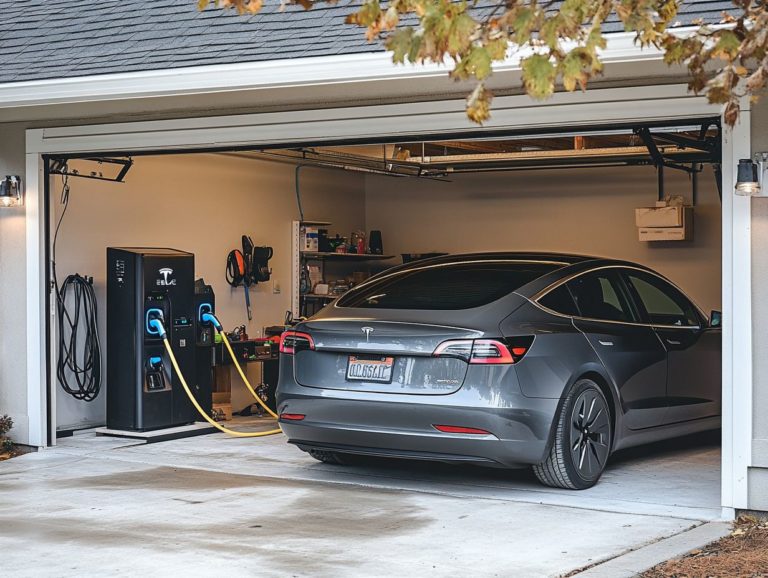how do evs perform in extreme weather?
Electric vehicles (EVs) are reshaping the automotive landscape. But how do they perform in extreme weather conditions?
From scorching heat to biting cold, temperature significantly impacts battery life and overall performance.
This article delves into the effects of temperature on EVs. It examines the challenges they encounter in harsh climates and the innovative strategies being implemented to enhance their functionality.
You’ll also discover real-world case studies and explore future advancements aimed at optimizing EV performance, regardless of the weather. Embark on this journey as you navigate the complexities of EVs in extreme conditions and uncover the exciting possibilities that lie ahead in this dynamic field.
Contents
Key Takeaways:
- Extreme temperatures affect battery life.
- Heating and cooling systems help maintain performance.
- Real-world examples provide insights for improvement.
- Future tech promises better performance.

What are EVs?
Electric vehicles, or EVs as they’re often called, mark a transformative leap in transportation technology. They are designed to minimize greenhouse gas emissions and tackle climate change head-on.
These vehicles harness the power of lithium-ion batteries, which efficiently store and deliver energy to electric motors. This offers a compelling alternative to traditional fossil fuel-powered options.
As your interest in EV ownership deepens, you’ll find that aspects like battery performance, charging infrastructure, and environmental impact are coming under greater scrutiny. This is aimed at ensuring a sustainable future for both personal and commercial transport.
Performance of EVs in Extreme Weather
The performance of electric vehicles (EVs) in extreme weather conditions presents noteworthy challenges. These challenges can impact battery temperature, range, and the overall ownership experience.
Grasping how these vehicles function under such circumstances is vital for optimizing their performance. It is essential to ensure dependable charging at EV stations.
Extreme temperatures can significantly affect battery efficiency. It is important for you to understand these dynamics for a seamless EV experience.
Effects of Temperature on Battery Life
Temperature plays a pivotal role in determining the battery life of electric vehicles. This is especially true for those equipped with lithium-ion batteries, which are particularly sensitive to extreme cold and heat.
When temperatures soar or plummet, you may notice a decline in battery performance. This directly impacts your driving range and the overall efficiency of your EV.
It s essential for you to grasp how to manage battery temperature effectively. Employing strategies like preconditioning is critical.
In sweltering heat, the chemical reactions in these batteries can speed up. This can cause them to degrade more quickly and potentially lead to thermal runaway a dangerous situation that could result in fires or battery failure.
Conversely, frigid temperatures slow down these vital reactions. This hampers the battery’s ability to deliver power efficiently and ultimately reduces your driving range.
To combat these temperature-related issues, many EVs are equipped with advanced battery management systems. These systems monitor temperature and adjust performance as needed.
Preconditioning lets you heat or cool your battery before hitting the road. By implementing these strategies, you can significantly enhance your vehicle s longevity and reliability, ensuring optimal performance no matter the weather.
Challenges in Cold and Hot Weather

Electric vehicles encounter distinct challenges in both cold and hot weather. These challenges can significantly affect charging processes, battery range, and overall energy consumption.
In frigid conditions, battery performance can drop sharply. This leads to a reduced range and difficulties locating compatible EV chargers. Conversely, high temperatures can hasten battery degradation, making effective management essential.
To tackle these challenges, consider the following strategies:
- Precondition your vehicle using features available at charging stations. This allows the battery to warm up before you hit the road or plug in.
- Employ insulation or protective covers to help stabilize temperature fluctuations.
- During hotter months, maintain moderate battery levels instead of letting it fully charge or deplete. This practice can extend battery lifespan.
Knowing your local charging options is vital for long trips. This knowledge ensures you won’t be caught off guard. By implementing these strategies, you can optimize your EV s performance, even in extreme weather conditions.
Strategies for Improving EV Performance in Extreme Weather
To elevate electric vehicle (EV) performance in extreme weather, manufacturers and researchers are crafting innovative strategies. These strategies emphasize controlling temperature and using sophisticated battery management systems.
These cutting-edge technologies optimize battery temperature through methods like preconditioning. This ensures that EVs operate efficiently and use energy effectively while charging at EV charging stations.
Heating and Cooling Systems
Heating and cooling systems are essential for managing temperature in electric vehicles. They directly influence battery temperature and the overall performance of your EV.
These systems ensure that lithium-ion batteries operate under optimal conditions. This enhances energy efficiency and extends battery life, even when faced with challenging temperatures.
By regulating the vehicle’s internal temperature, these systems improve energy efficiency and enhance passenger comfort. Efficient temperature control is vital in extreme weather, where excessive heat or cold can negatively impact battery performance and longevity.
The interaction between heating and cooling systems and electric drive motors is crucial. Striking a balance maximizes energy efficiency. Investing in advanced temperature management technologies is essential in the electric vehicle sector, as it affects your vehicle’s range and reliability.
Battery Management Systems
Battery management systems (BMS) are crucial for optimizing both performance and safety in electric vehicles. These systems focus on temperature control, improving energy efficiency and extending battery life.
BMS continuously monitor battery conditions and manage charging processes. They ensure stable operation, even in varying environmental factors. By assessing voltage levels, temperature, and state of charge, these sophisticated systems prevent overheating and significantly increase battery lifespan.
The BMS plays a vital role in balancing cell performance. This ensures that every cell within the battery pack operates uniformly. This meticulous balancing enhances energy density and mitigates the risk of premature failure.
As the automotive industry embraces sustainability, integrating advanced battery management systems is essential. This integration tackles challenges related to energy consumption and improves temperature management, making electric vehicles more reliable and environmentally friendly.
Real-World Examples of EV Performance in Extreme Weather

Real-world examples and case studies offer invaluable insights into how electric vehicles perform in extreme weather. You ll discover how factors like temperature and the availability of EV chargers significantly influence driving range and efficiency.
By analyzing data from these case studies, you can uncover essential performance metrics. These metrics guide both manufacturers and consumers in optimizing EV usage across varying climates.
Explore local EV networks today to maximize your driving experience in any weather.
Case Studies and Data Analysis
Examining case studies and conducting data analysis on electric vehicles’ performance in extreme weather offers crucial insights into how environmental factors influence EV ownership and user experience.
By analyzing performance metrics across various conditions, valuable trends emerge that can guide your future decisions and inform developments in the industry.
For instance, consider a recent study that explored how temperature changes affect battery efficiency and overall range in regions with harsh winters or summers.
Researchers meticulously collected data and measured key metrics such as how long it takes to recharge, energy consumption, and driving range under different environmental scenarios.
These findings highlight potential improvements manufacturers could make to battery technology and how they manage temperatures, ultimately boosting reliability and user satisfaction.
Consumer feedback from these extreme environments adds valuable context, pinpointing critical areas for innovation and responsiveness to climate-related challenges in EV design.
Future Developments in EV Technology for Extreme Weather
Future developments in electric vehicle technology are ready to transform the performance of EVs in extreme weather. Innovations in how vehicles manage battery temperatures and battery technology are leading this change.
As manufacturers tackle challenges posed by climate change, these advancements will significantly enhance the reliability and efficiency of EVs, ensuring they perform well in a wide range of environmental conditions.
Innovations and Advancements
Innovations in battery technology are essential for improving electric vehicle performance, especially in extreme weather conditions.
New approaches currently under research aim to boost efficiency, prolong battery lifespan, and address the effects of climate change on EV performance.
One of the most exciting developments involves batteries that perform well in both high and low temperatures. These batteries not only provide a higher energy density but also reduce the risk of overheating, which is a key concern in very hot environments.
Advancements in how vehicles manage battery temperatures are being implemented to ensure optimal performance across different climates. Manufacturers are increasingly focusing on smart systems that monitor and adjust battery usage, maximizing your vehicle’s range while preventing damage during harsh weather.
Together, these innovations represent a significant shift in how electric vehicles can adapt to and thrive in challenging environments.
Frequently Asked Questions

How do EVs perform in extreme weather?
EVs can handle extreme weather conditions, but their performance may vary based on factors like temperature. For instance, how cold weather affects EV performance is an important consideration for electric vehicle owners.
What is considered extreme weather for EVs?
Extreme weather for EVs includes extreme temperatures, heavy rain or snow, and strong winds. These conditions can impact the range, charging, and overall performance of an EV.
Do EVs have reduced range in extreme weather?
Yes, EVs may experience reduced range in extreme weather conditions. In very cold temperatures, the battery may lose some capacity, leading to a decrease in range. In hot weather, increased energy demands for cooling can also reduce capacity and range.
Do EVs have special features to handle extreme weather?
Some EVs include special features for extreme weather conditions. For example, certain models have systems to manage battery temperatures in very hot or cold weather. Others may come with heated seats and steering wheels for added comfort in cold conditions.
Can EVs be charged in extreme weather?
Yes, EVs can be charged in extreme weather conditions. However, charging time and speed may be affected by extreme temperatures. It is recommended to charge the EV at moderate temperatures for optimal charging performance.
How Can EV Owners Prepare for Extreme Weather?
EV owners can prepare for extreme weather by storing their vehicles in a garage or covered parking. Pre-conditioning your EV before driving is essential to conserve battery life in harsh conditions.
Don’t wait! Regular maintenance is crucial to keep your EV in top shape, ensuring it can tackle extreme weather effectively.






